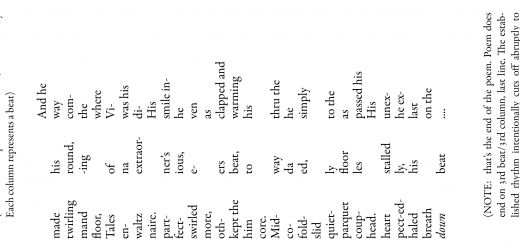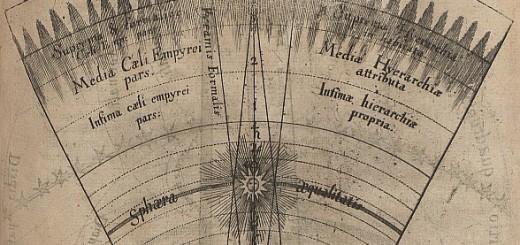Crossing Borders
Each month, Echo partners with our friends at Ethnomusicology Review to bring you “Crossing Borders,” a series dedicated to featuring trans-disciplinary work involving music. ER Associate Editor Leen Rhee (leenrhee@ucla.edu) welcomes submissions and feedback from scholars working on music from all disciplines.
Drone and Harmonic Variation: Finding a Constant Through Chord Changes
Submitted by Patrick Doyle
While camping together in Big Bear Mountain in Southern California, a friend of mine found the perfect soundtrack for the incredibly relaxed and serene atmosphere. The song she selected was Henry Flynt’s “Blue Sky, Highway, and Tyme” from his anthology titled Raga Electric: Experimental Music 1963-1971, which was released in 2002. We sat in a circle around a pair of laptop speakers that vibrated Flynt’s mellow tones throughout the mountainside. The piece spans just over fifteen minutes—the majority of which comprises of a single acoustic guitar playing the same double stop phrase repeatedly with Flynt singing over the top. There is little variation from this structure for most of the piece until the last two minutes when Flynt plays a brief interlude consisting of a completely different double stop pattern—using it as a segue into a different time signature and harmony for 24 bars—before pausing and returning to the original harmony. Some minute variations occur as the song progresses, but for the most part, Flynt plays the main double stop phrase with almost zero deviation from the repetition.
In an attempt to get into the spirit of things, I spent most of the song seated with my eyes closed. During the last thirty seconds of the piece, in which Flynt sings the song’s only lyrics, I opened my eyes to find the rest of my camping group also seated with their eyes closed. It was as if the song was a pendant dangling in 3/4 time in front of us to which we were all transfixed.
Previously, when I thought about music that induces a meditative or mesmeric reaction from the listener, I thought about music in which the same single tone or chord was either repeated consistently or played as a single drone by the performer. What was being presented to me in “Blue Sky, Highway, and Thyme” was a repetitive and frantic guitar riff that was made up largely of passing tones which was achieving the same effect. I realized then, what steadily crept in throughout the duration of the song was the tonic, low and humming, in overtones resonating through Flynt’s acoustic guitar. I had heard a similar effect previously, in which a drone is developed throughout a song by way of overtonal resonance, in another song by the doom metal band Sunn O))) titled “It Took the Night to Believe.”
https://www.youtube.com/watch?v=tRQLsZDV2mY
This intrigued me as someone who writes doom metal and ambient music that is highly repetitive and often utilizes single chord drones. After hearing the tonic resonate through Flynt’s guitar, I believed it was possible to write a piece that has pronounced chord changes but still puts an emphasis on a tonic drone. This could be achieved by borrowing techniques from both Henry Flynt and Sunn O))) in order to create resonance that shares equal billing with the chord changes themselves.
Upon first listen, Henry Flynt’s work can sound like a cacophony of glissandi extreme repetition, and phrases of passing tones that never quite reach a resolution. However, at the core of those pieces is often one chord. In his essay The Meaning of My Avant-Garde Hillbilly and Blues Music (1980), Flynt explains “I often eliminate chord changes from my music, because I experience changes in root like stoplights on a highway.” 1
In other words, think of the performer of “Blue Sky, Highway, and Thyme” as a commuter in a sedan keeping a constant speed of sixty-five miles per hour across the I-90. The guitar part provides the constant whir of the engine, while the vocals may represent the commuter making slight changes as the road twists and turns. During such a drive, the commuter may allow their thoughts to wander, putting trust in their constant speed and miles of empty road ahead of them. Flynt believes that a chord change in that piece would be a disruption to that commute—something like a sudden influx of traffic or a complete stop. Similar to how a sudden stop from sixty-five miles per hour would disrupt the driver’s calm morning commute, a chord change would disrupt the meditative flow of Flynt’s music.
Let there be no confusion between Henry Flynt’s distaste for composing music with chord changes and music that utilizes a tonic drone. Flynt puts it plainly: “I do not use drones.” 2 Instead, Flynt employs “a bluesy-country system of dyadic progressions (over an implied tonic pedal point) which I employ when playing extended passages of rapid double stops.” 3 A single song is distilled by Flynt down to one lead, dancing around the tonic, repeated over and over again. Outwardly, this sounds like a series of passing tones, but the root shines through. In “Blue Sky, Highway, and Thyme,” Flynt plays the same series of double stops, at the same tempo, for the majority of the song. The tonic pedal point is “implied,” as Flynt puts it, because there is no instrument actually holding down the tonic. Rather, there is just a lack of chord changes. I will go a step further and say that this pedal point the listener is hearing manifests itself in a constant tonic hum, similar to a drone. If this can be achieved through a repeated phrase made up largely of passing tones, then certainly it can be adopted in conjunction with techniques used by Sunn O))) to imply the tonic over multiple chord changes.
A similar effect to Flynt’s “implied tonic pedal point” is found in Sunn O)))’s “It Took the Night To Believe” off of their second full length release, Black One (2005). Sunn O)))’s attempts at making heavy metal that allows the listener to enter into a “meditative state or trance” often leads to as many comparisons to composers, such as LaMonte Young and Phillip Glass and other bands, including Black Sabbath and Entombed.4 Sunn O)))’s music is often devoid of melody and traditional (or any) song structure. Instead, many of their songs contain long passages of sustained feedback and droning chords—a style originally developed by the band Earth. When asked about the band’s influences in a 2006 New York Times interview, guitarist Stephen O’Malley said:
“We’re really interested in Tony Conrad, Steve Reich, all those minimalist composers. They took a point—one point in a possible progression or series of notes—and elaborated all of the possibilities that were latent there. The microcosmic approach—Sunn O))) does that a lot.” 5
“It Took the Night to Believe” (2005) is an example of the microcosmic approach—in which the band reduces a song down to one aspect, such as a repeated chord or phrase, and extracts from it all of its possibilities over a long duration. Yet, the song does not rely on droning chords. Rather, the band employs a steady progression of chords that is tremolo picked. In the metal world, this technique is commonly used in the black metal genre and is generally played in time with a drummer playing blast beats. Stripped of drummer, however, the tremolo picked guitar plays a similar role to that of the guitar in “Blue Sky, Highway, and Thyme,” playing rhythmically around the tonic. Simultaneously, a second guitar plays counterpoint, sometimes arrhythmically, holding down the song’s chord progression. After the black metal vocalist, Wrest adds his vocals. The end result is a disorienting piece that is stylistically closer to that of a European black metal band than any of Sunn O)))’s previous and more drone oriented work.
Like “Blue Sky, Highway, and Thyme,” there is no instrument that is playing a straight tonic drone throughout the song. Rather, “It Took the Night to Believe” is structured with a I-I-iii-ii progression. As the song progresses, the tonic drone makes itself apparent through harmonic overtones that are brought out by the use of distortion, tape delay, and reverb on both guitars. These effects allow for resonance to build both guitars over the course of the song so that each time the chord progression is started the progression before it rings out. By the end of the song the formerly frantic and disparate parts blur together in a single drone while still maintaining individual clarity.
***
When I had previously considered composing drone music, I thought only of one chord. If played ceaselessly, that one chord could provide hidden melodies of feedback and overtones on which the listener could meditate. After considering the techniques employed by Henry Flynt and Sunn O))), it occurred to me that I had been severely limiting the harmonic variation for which drone music is capable. I set out to write a piece that relied more on an “implied tonic pedal point,” as opposed to a single chord drone, so I could use pronounced chord changes. The result was a piece for solo guitar titled “Mountain Dampness.”
In the spirit of Flynt’s “Blue Sky, Highway, and Thyme.” I originally wrote “Mountain Dampness” for acoustic guitar. However, instead of adopting Flynt’s technique of using a series of repetitive double stops that dance around the tonic, I elected to play three chords in 3/4 time. The chords I chose were Dm, F, and C, which are tremolo picked in first position. These three chords share many common tones and progress easily as an implied ii-IV-I. I play the chords softly in hopes that the their overtonal resonances gain equal footing with the chords themselves allowing the listener the option to focus on either the chord progression or the drone. After several minutes of repetition, I hoped that the listener would hear the C triad persist through the Dm and F triads when it is not being played.
Duration is necessary to build up that resonance, as shown in both Flynt and Sunn O)))’s pieces. During the first performance, I found the overtones of the C triad resonating through the acoustic guitar after fifteen minutes of repeating the progression. As I intended this song to be a folk tune—one which does not require an expert knowledge of the guitar or a musical background to perform—there is no notation or requirements for duration. The song ends when the performer is too tired to carry on. Although there are no set requirements, it is recommended that the song is played at a tempo that allows the performer to play long enough for the guitar to build overtonal resonance so that the drone effect is reached.
When I recorded this piece, I elected to perform it on an electric guitar which was run through a similar effects set up that Stephen O’Malley of Sunn O))) uses: reverb, tape delay, and distortion. This was done in an attempt to bring out the metallic sound in music that was originally not rooted in a heavy metal tradition. As a result of the addition of these effects, I found that the C chord started to resonate over the top of the progression almost immediately during the recording process. The fluidity that the reverb provides gives a cascading effect each time a chord change is made. The result is a mesh of two distantly linked performers’ techniques that, I hope, brings a new idea to the table. Like the constant hum of a large city can be attributed to the sum of its inhabitants carrying out their lives, the constant hum of “Mountain Dampness” can be attributed to the sum of its three chords and their performance.
When I think about the performer of “Mountain Dampness,” I think of a driver who has recently broken free of Los Angeles traffic and is driving east up the narrow Route 38 through the San Bernardino Mountains. Although the traffic is long gone and the driver can maintain a steady speed, the frequent hairpin turns must be accounted for—forcing full focus on every detail of the task at hand. A touring musician friend once told me those were his favorite drives because he had to find a different sort of meditative state—one that accepted and accounted for sound wave pattern on which he was driving but maintained the relaxed attitude needed for long drives. Perhaps Henry Flynt was wrong about chord changes. They aren’t stoplights on a highway, but twists and turns up a winding mountain road.
***
Patrick Doyle is a writer and musician living in Los Angeles. He is currently a member of the Western New York based ambient doom band Rash and the Los Angeles based punk band Having Had Done. He is releasing a full length album of solo guitar pieces titled Rust Belt Feeling in January 2016.
- Flynt, Henry A., Jr. “The Meaning of My Avant-Garde Hillbilly and Blues Music.” The Meaning of My Avant-Garde Hillbilly and Blues Music. Backworks, 1 Jan. 2002. Web. 3 Nov. 2015. <http://www.henryflynt.org/aesthetics/meaning_of_my_music.htm>. ↩
- Ibid. ↩
- Ibid. ↩
- Wray, John. “Heady Metal.” The New York Times. The New York Times, 27 May 2006. Web. 28 Nov. 2015. ↩
- Ibid. ↩



